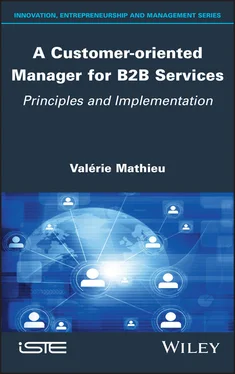1 Cover
2 Title Page Series Editor Régine Teulier
3 Copyright First published 2022 in Great Britain and the United States by ISTE Ltd and John Wiley & Sons, Inc. Apart from any fair dealing for the purposes of research or private study, or criticism or review, as permitted under the Copyright, Designs and Patents Act 1988, this publication may only be reproduced, stored or transmitted, in any form or by any means, with the prior permission in writing of the publishers, or in the case of reprographic reproduction in accordance with the terms and licenses issued by the CLA. Enquiries concerning reproduction outside these terms should be sent to the publishers at the undermentioned address: ISTE Ltd 27-37 St George’s Road London SW19 4EU UK www.iste.co.uk John Wiley & Sons, Inc 111 River Street Hoboken, NJ 07030 USA www.wiley.com © ISTE Ltd 2022 The rights of Valérie Mathieu to be identified as the author of this work have been asserted by her in accordance with the Copyright, Designs and Patents Act 1988 Library of Congress Control Number: 2021949549 British Library Cataloguing-in-Publication Data A CIP record for this book is available from the British Library ISBN 978-1-78630-757-6
4 Foreword
5 Preface
6 PART 1: Understanding the Fundamentals of Customer Orientation in B2B Services Introduction to Part 1 Introduction to Part 1 This first part presents the three fields at the intersection of which this book is positioned: customer orientation, service and B2B. Customer orientation is debated in a dense literature that focuses on defining and justifying its benefits and also questions how it can be implemented in the company. This customer orientation is a direct result of the marketing culture. Translated into a managerial skill, customer orientation allows for the diffusion of a marketing culture within the organization as a whole. The interest in the service sector in particular is justified by its economic weight and also indicates the need for a specific approach in order to implement customer orientation in a relevant and effective way. It is, thus, necessary to understand the reality, the stakes and the specificities of the service sector in order to introduce an adapted customer orientation. As for the focus on B2B, it implies a significant distinction between B2B and B2C in terms of customer orientation. One often resorts to endless lists to justify what distinguishes B2B from B2C. Two specificities are in fact essential to understand, the first one is related to the market and the second one to the relationship. While the first one, involving the notions of channel and derived demand, is specific and exclusive to B2B markets, the second one, which defends the importance of the relationship between customers and their providers, is also at the heart of B2C. Nevertheless, the B2B relationship, because of its strength, depth and duration, is becoming a major managerial challenge.
1 Customer Orientation 1 Customer Orientation 1.1. Outlines and challenges of customer orientation Customer orientation is an old hand in the young management literature. The concept appeared a little more than 30 years ago 1 and has been attracting the attention of researchers, consultants and managers ever since.
1.1. Outlines and challenges of customer orientation 1.2. Marketing as the source of customer orientation 1.2. Marketing as the source of customer orientation By putting customers and their satisfaction at the heart of its ambitions, customer orientation is intimately associated with marketing. Customer orientation can also be considered as the implementation of the marketing concept 13 . To better understand the marketing concept and its implementation is then a natural step to better enter in the customer orientation.
1.3. The manager’s customer orientation in response to marketing issues 1.3. The manager’s customer orientation in response to marketing issues We must distinguish between function and culture. If marketing as a function is now facing certain challenges, its original culture, that is, the customer at the heart of the company, is more relevant than ever. The customer-oriented company can neither be the exclusive project of a department, even if it is a marketing department, nor the strategic vision of the management committee alone. Making customer orientation a managerial skill is, therefore, a response to the challenges of marketing and a powerful lever for achieving the promises of a customer culture in the company.
2 Reality and Challenges of Service 2 Reality and Challenges of Service 2.1. Economy and service: from data to discourse Service dominates the economies of developed countries and plays a major role in development. While economic analysis strongly emphasizes the weight of service in our economies, interpretations of this reality are far from consensual.
2.1. Economy and service: from data to discourse 2.2. Defining the service 2.2. Defining the service Services have historically been defined by default as activities that cannot be classified in industry or agriculture according to the usual INSEE nomenclature. Economic science has been particularly concerned with approaching a definition of service, with the desire to move beyond the debate between material and immaterial and productive and unproductive, and by focusing more on the conditions and characteristics of service production 7 . While it remains ambitious to try to define service, it is still necessary to understand it. Two complementary angles, the organizational angle and the market angle, can contribute to understanding it.
2.3. Characteristics of the service 2.3. Characteristics of the service Service has characteristics that distinguish it from a product 12 . Beyond the knowledge of these characteristics, the manager must manage the implications that have specificities in a B2B context.
3 Markers of B2B
3.1. Reality of the market 3.2. The relational issue
7 PART 2: Knowing the Customer Introduction to Part 2
4 Modeling the Industrial Sector
4.1. Direct market 4.2. Indirect actors
5 Understanding the Purchase
5.1. Buying center concept 5.2. Buying process
6 Identifying Service Targets
6.1. Different types of targets 6.2. Target satisfaction challenge
8 PART 3: Making the Most of the Offer Introduction to Part 3
7 Acting Against the Risk of Commoditization
7.1. Understanding the phenomenon of the offer commoditization 7.2. Countering the commoditization of the offer
8 Formalizing Your Offer
8.1. Positioning the offer 8.2. Design of the service offer
8.3. Plasticity of the service offer
9 Taking Care of One Commercial Action
9.1. Commercial proposal 9.2. Commercial negotiation
9 PART 4: Delivering the Service Delivering the Service Part 4
10 Unlocking Human Potential
10.1. Associating the client 10.2. Mobilizing the team
11 Managing Service Operations
11.1. Operational efficiency 11.2. Manager’s responsibility for customer-oriented operations
12 Marketing the Tangibles
12.1. Tangible elements of the service 12.2. Challenges of tangibles
10 Conclusion
11 References
12 Index
13 End User License Agreement
1 Chapter 1Table 1.1. Over-quality and customer delight
2 Chapter 4Table 4.1. Defining one’s marketTable 4.2. Dual segmentation for B2B services
3 Chapter 7Table 7.1. Total cost of ownership in business tourism
Читать дальше

![Matthew Vincent - [you] Ruined It for Everyone!](/books/216429/matthew-vincent-you-ruined-it-for-everyone-thumb.webp)










